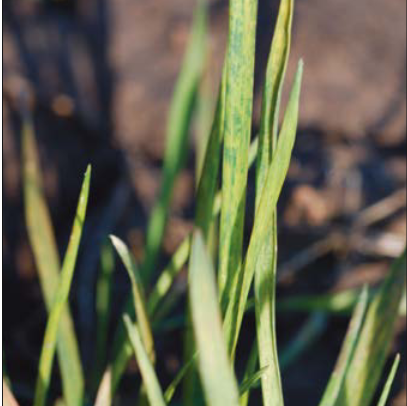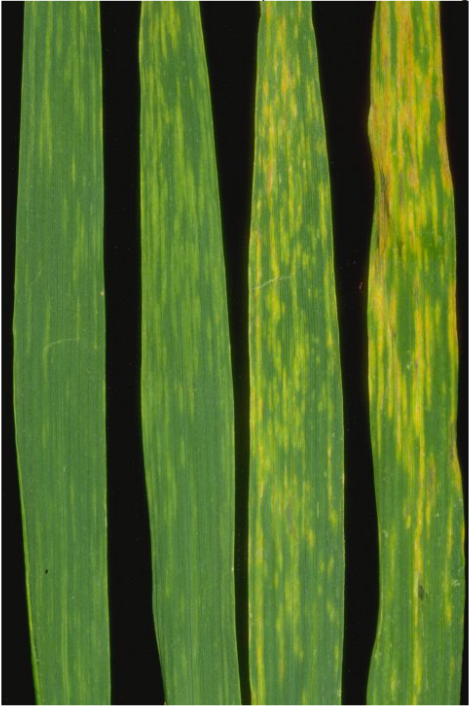 Figure 1. Symptoms of soil borne wheat mosaic virus. Image Erick De Wolf, KSU
Figure 1. Symptoms of soil borne wheat mosaic virus. Image Erick De Wolf, KSU
- Cool season viruses are often overlooked yield robbers in wheat
- Scouting and testing for viruses can help determine future management decisions, improve yields, and avoid unneeded inputs
- Reduce potential losses by selecting resistant varieties in fields with a history of these diseases, reducing compaction and drainage issues in fields, and harvesting affected fields separately to avoid spreading to other production sites.
Viruses are non-living pathogens consisting of genetic material surrounded by a protein coat. Once inside a suitable host, these pathogens hijack the plants own systems to reproduce themselves, diverting energy and resources from plant growth into production of the virus. In addition, viruses can impact the balance and production of hormones within the plant, resulting in altered growth patterns, reduced growth and tillering, or abnormal development. Viruses cannot be cultured on artificial media, and only can be confirmed with specialized tests in a lab. This publication briefly discusses two commonly occurring cool season viruses of wheat, their identification, and potential management considerations.
There are two major viruses of wheat that often go unnoticed by scouts and producers and likely cause hidden yield losses in fields. These include soilborne wheat mosaic virus (SBWMV) and wheat spindle streak mosaic virus (WSSMV). Both viruses are transmitted by a soil borne protozoan that persists in soils for at least 8 years in the absence of a susceptible host. When soils are wet, this fungus infects wheat seedlings, infecting plants with the virus. Often, WSBMV and WSSMV symptoms occur from greenup through Feekes growth stage (FGS) 6/7 when conditions are cool and favor viral replication. Once temperatures increase past 64°F (WSSMV) or 68°F (SBWMV), these viruses will no longer produce symptoms in new tissues, though older tissues will still be symptomatic. Consequently, these viruses are often misdiagnosed as Nitrogen or Sulfur deficiencies in the crop, and the application of split Spring nitrogen at FGS 5, as occurs frequently in Eastern wheat production systems, often is viewed as correcting the problem. Scout for symptomatic plants from greenup through flag leaf emergence by assessing plants at 2 locations per 10 acres of field for viral symptoms. If suspect plants are detected, contact your local plant diagnostic clinic for confirmation.
Disease symptoms
SBWMV: Plants infected with the soilborne wheat mosaic virus occur as patches of light green - yellow -purple wheat within a field. Foliar symptoms typically include a mosaic of green and yellow islands, resembling camouflage clothing in many ways (Figure 1). Infected plants are often stunted when compared to virus free plants at the end of the season.
WSSMV: After greenup, yellow/green dashes that run along the leaf veins appear on foliage (Figure 2). Over time, these dashes become pointed at the ends with a green area of tissue in the center, resulting in classic, “spindle” lesions (Figure 2). Diseased plants green up more slowly than healthy plants, and if cool conditions persist, affected plants may be stunted and thin. Highly susceptible varieties may develop necrotic lesions resembling bacterial leaf streak or Septoria leaf blotch. If symptoms persist into the flag leaf stage or later, losses of up to 35% can occur.

Figure 2. Symptom expression in wheat infected with wheat spindle streak virus. Note the tapered ends to the lesions, which run with leaf veins. Image R. Bowden, KSU
Management
Once either virus is confirmed in a field, a management plan should be followed any time wheat is planted in the field. Yield impacts can be effectively minimized by planting moderately resistant varieties. This characteristic is often listed as a “soilborne virus” rating on wheat variety description sheets. Because the vector of the viruses is favored by wet soil, reducing compaction and improving drainage can help reduce potential damage. Lastly, avoid spreading the vector and virus into other fields by working affected fields separately from unaffected fields.